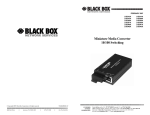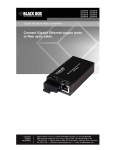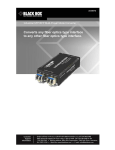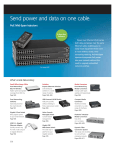Download Black Box MultiPower Miniature
Transcript
Free 24-hour Tech support: 724-746-5500 blackbox.com © 2012. All rights reserved. Black Box Corporation. Multipower Miniature Media Converters These media converters enable you to use fiber almost anywhere! 9/25/2012 #10858 1 of 7 Multipower Miniature Media Converters extend your 10/100BASE-T network beyond the 328-foot (100-m) limit—perfect for connecting remote workstations. Features » Convert 10- or 100-Mbps copper ports to fiber optic cable. » Bring fiber to the desktop more economically than fiber NICs. » Compact size makes them easy to integrate. » Autonegotiating for speed and duplex. Duplex Single-Mode Fiber Optic Cable up to 43.5 miles (70 km) CATx Cable Miniature Media Converters (LHC013A-R2) Miniature Media Converters (LHC013A-R2) CATx Cable CATx Cable 16-Port Pure Networking™ 10/100 Ethernet Switch (LB8516A) PCs with 10- or 100-Mbps Copper Ethernet Ports CATx Cable Duplex Single-Mode Fiber Optic Cable up to 43.5 miles (70 km) OVERVIEW Now it’s easier than ever to bring fiber to your network, no matter if your network is spread across a business campus, a large industrial site, or over great distances and/or subjected to temperature extremes. The Multipower Miniature Media Converters bring fiber to the desktop. Good things, small packages. Multipower Miniature Media Converters are easy to install (literally plug-and-play), tiny enough to fit in anywhere, and very economical. Use them to bring fiber to the desktop or add fiber segments to your network to gain extra distance—up to 43.5 miles (70 km) with single-mode fiber. Twice the conversion power! A Multipower Miniature Media Converter enables you to connect 10-Mbps and 100-Mbps twisted-pair network segments to fiber optic cabling. It’s both a media and data rate converter with 10/100 auto-negotiation on the twisted-pair port. The fiber port operates at 100 Mbps. You can also choose Gigabit models to link 1000BASE-TX twisted-pair network segments to 1000BASE-LX fiber optic cabling. All Multipower Miniature Media Converters have an HDX/FDX function for half- and full-duplex autosensing. 9/25/2012 #10858 724-746-5500 Installation is easy. Just connect a Multipower Miniature Media Converter to the RJ-45 connector on your PC’s 10- or 100-Mbps Ethernet port using CAT5e cable, then connect fiber optic cable to the other side of the media converter. What’s more, these tiny converters tuck unobtrusively behind your PC. Go the distance with fiber. Multipower Miniature Media Converters using multimode fiber support distances of up to 984.2 feet (300 m) or 1.2 miles (2 km)— enough distance for most LAN applications. For more extensive campus applications, choose Single-Mode or Single-Mode, Single-Strand models for long-distance runs of up to 6.2, 12.4, 24.8, or 43.5 miles (10, 20, 40, or 70 km). Three power options. Multipower Miniature Media Converters can be powered one of three ways: by an external AC power supply included with each unit, by an optional USB Power Adapter Cable that plugs into a PC’s USB port, or by an optional rackmount PowerTray. The AC power supply is a universal external transformer that requires a nearby AC power outlet. The PowerTray provides power for up to 18 converters in only 1.5U of rack space. Rackmount ears are included. blackbox.com 2 of 7 BLACK BOX ® Technically Speaking 100-Mbps Ethernet. Power Tray (LHC018A-AC-R2) filled with Miniature Media Converters. 100BASE-T: an overview. 100BASE-T, also known as Fast Ethernet, is a high-speed version of the 10BASE-T Ethernet standard. 10BASE-T data and 100BASE-T data are essentially the same: The only difference is that to attain higher data throughput, the 100BASE-T standard reduces the latency period between data bits. This increases data throughput from 10 to 100 Mbps. You can build a network that’s entirely Fast Ethernet, you can use it as a VLAN, or you can deploy Fast Ethernet as an “island” within your 10-Mbps Ethernet network. Here are the most common 100BASE-T standards endorsed by the Institute of Electrical and Electronic Engineers (IEEE): 100BASE-TX. 100BASE-TX is the most popular Fast Ethernet standard. 100BASE-TX operates over Category 5 or higher cable and uses two pairs of wires, which enables it to support both half- and fullduplex operation. Because Category 5 or higher cable is used in many existing 10BASE-T networks, 100BASE-TX is also the most convenient way to implement Fast Ethernet into an existing 10-Mbps network. As with 10BASE-T, distances between devices in a 100BASETX network cannot exceed 100 meters (328 ft.), though the use of extenders and line drivers can increase this distance somewhat. This distance limitation applies to both full- and half-duplex operation. 100BASE-FX. 100BASE-FX, the fiber version of Fast Ethernet, supports halfand full-duplex network operation over single-mode or multimode duplex fiber optic cable. Because fiber optic cable has such a high performance capacity, 100BASE-FX is ideally suited for use as a backbone cable or an extra-long Ethernet connection—for example, a building-tobuilding link. Over fiber, the maximum distance for a cable is 412 meters (1351.7 ft.) in half-duplex mode and 2 kilometers (1.2 mi.) in full-duplex mode. 100BASE-T4. This is the least popular of the 100BASE-T standards. 100BASE-T4 uses only three pairs of wires for data transfer and one for collision detection. So, unlike 100BASE-TX and 100BASE-FX, 100BASE-T4 can only support half-duplex network operation. This significantly limits its use because 100-Mbps islands are normally added to networks to support high-bandwidth, full-duplex network applications. According to some sources, less than 1% of 100BASE-T applications use 100BASE-T4 and many manufacturers have completely discontinued 100BASE-T4 product lines. The advantage of 100BASE-T4 is that it operates over Category 3, 4, and 5 cable and functions quite well in noisy environments—giving the standard an element of flexibility in UTP Fast Ethernet applications not shared by 100BASE-TX or 100BASE-FX. The distance limitations for the 100BASE-T4 standard is the same as 100BASE-TX: 100 m (328 ft.). Why replace 10BASE-T Ethernet? Fast Ethernet hasn’t come close to completely replacing 10BASE-T Ethernet, but in some cases, 10BASE-T simply can’t keep up with new multimedia applications and large files that have become a large part of many corporate networks. (continued on page 4) NOTE: The LHC040A-R2 and LHC041A-R2 operate at 850-nm wavelength, so they meet the 100BASE-SX standard. NOTE: Multipower Miniature Media Converters do not work with a 10BASE-FL fiber interface. 9/25/2012 #10858 724-746-5500 blackbox.com 3 of 7 BLACK BOX ® Technically Speaking (continued from page 3) And with increased network density, data throughput suffers greatly. Some earlier solutions to lagging network throughput looked promising. For example, using full-duplex switches on a 10-Mbps network—known as “switched Ethernet”—effectively increased data rates to 20 Mbps. However, many high-bandwidth applications and large data files have since outgrown switched Ethernet. The solution. In light of these issues, adding 100-Mbps network segments, or “islands,” to existing 10BASE-T networks has become a popular method of improving network throughput, and some features of Fast Ethernet make this option an attractive one. First, because the data is constructed the same way for both 10BASE-T and 100BASE-T, 100BASE-T is interoperable with 10BASE-T through the use of 10-/100-Mbps devices. Plus, the cost of adding these 100-Mbps network islands to your Ethernet is minimal, especially when compared to the cost of a full-blown network upgrade. How do I add 100BASE-T to my Ethernet LAN? You can add a 100BASE-T island to your 10BASE-T network with a 10-/100-Mbps Ethernet hub or a 10-/100-Mbps Ethernet switch. If you use a hub to incorporate Fast Ethernet into your network, the hub will simply provide a link between the 10-Mbps network and the 100-Mbps network islands. However, hubs have no addressing features and do not differentiate among destinations for information packets. In this case, the network is simply extended and you may experience inefficiencies in data transfer between the two sides. 9/25/2012 #10858 724-746-5500 Switches are usually a far more effective choice for building Fast Ethernet islands because they have addressing features that retime, filter, forward, and drop network packets. When you use switches, your network is actually segmented into separate collision domains. The rules of the game. There are a few rules to remember when you’re incorporating Fast Ethernet into existing 10-Mbps networks: 1. Make sure you use the same 100BASE-T standard on your network. For example, if you’re connecting a PC with a 100BASE-TX NIC to a hub, the hub must also support 100BASE-TX. Also, some implementations of 100BASE-T aren’t interoperable. For example, 100BASE-TX won’t work with 100BASE-T4. 2. Make sure that your network hardware—PCs, printers, servers, hubs, switches, and routers— uses dual-speed autosensing architecture. This feature enables ports to sense the speed of the devices to which they’re connected and distinguish between 10 and 100 Mbps. For example, Ethernet print servers in a Fast Ethernet environment should be linked with a dual-speed, autosensing extender to convert between 10 and 100 Mbps. 3. Although many networks are linked with Category 5 or higher cable, some 10-Mbps networks use Category 3 cable, which doesn’t support 100-Mbps operation. If this is the case, you will have to upgrade your cabling plant to support Fast Ethernet. blackbox.com 4 of 7 BLACK BOX ® Technically Speaking 1000-Mbps Ethernet. The Gigabit Ethernet standard boasts a speed of 1000 Mbps, 100 times faster than 10BASE-T. And it works as promised— boasting speed, stability, true quality of service (QOS), and compatibility with older Ethernet standards. Gigabit Ethernet is generally used to provide the high bandwidth needed for high-speed network backbones and servers. The Gigabit Ethernet standard was approved in June 1998. A mere one year later, the IEEE 802.3ab standard for Gigabit over Category 5 twisted-pair cable was approved. Gigabit uplink ports are now a common feature in Ethernet switches. Gigabit is popping up left and right. So, what exactly is Gigabit Ethernet anyway, and how can you use it? First of all, Gigabit Ethernet is a true Ethernet standard and is compatible with both 10- and 100-Mbps Ethernet. Because it uses the same frame formats and flow-control methods as earlier Ethernet versions, networks readily recognize it. The primary difference is that Gigabit Ethernet almost always runs in full-duplex mode, rather than the half-duplex mode commonly found in 10- and 100-Mbps Ethernet. Full-duplex means a lot more bandwidth: A single Gigabit Ethernet switch port can handle traffic from as many as 20 half-duplex fast Ethernet links or up to 200 half-duplex Ethernet ports. When Gigabit Ethernet first appeared, fiber was crucial to running Gigabit Ethernet effectively. Since then, the IEEE 802.3ab standard for Gigabit over Category 5 cable has been approved, enabling short stretches of Gigabit speed over existing copper cable. The First Gigabit Standards: 1000BASE-X. 1000BASE-X refers collectively to the 1000BASE-LX, 1000BASE-SX, and 1000BASE-CX Gigabit Ethernet standards, ratified in 1998. 1000BASE-LX and 1000BASE-SX are fiber standards; 1000BASE-CX is an early copper standard that enabled Gigabit Ethernet to run over twinax cable. 1000BASE-LX. The “L” stands for “long” and it uses long wavelength lasers operating in the range of 1270 to 1355 nanometers to transmit data over fiber optic cable. 1000BASE-LX supports both single-mode and multimode fiber. 9/25/2012 #10858 724-746-5500 The “L” could just as well stand for “long distance.” 1000BASE-LX supports longer distances than shorter wavelength standards—up to 550 meters (1804 ft.) full- duplex over multimode fiber and up to 5000 meters (16,404 ft.) full-duplex over single-mode fiber. At half-duplex, 1000BASE-LX goes up to 316 meters. 1000BASE-SX. The “S” in 1000BASE-SX stands for “short.” 1000BASE-SX uses short wavelength lasers, operating in the 770- to 860nanometer range, to transmit data over fiber. It has the advantage of being less expensive than 1000BASE-LX but operates only over multimode fiber at distances up to 316 meters, half duplex or 550 meters, full duplex. 1000BASE-CX. The “C” stands for “copper” and 1000BASE-CX operates over copper twinax cable at distances of up to 25 meters. This standard never caught on, largely because of the short distance it covers. In addition, twinax cable is only slightly less expensive than fiber optic cable and is difficult to install. Gigabit over CAT5—1000BASE-T. The relatively new IEEE 802.3ab standard, approved in June 1999, defines running Gigabit Ethernet over Category 5 copper wiring. The importance of this is that now you can run IEEE-compliant Gigabit Ethernet over existing copper cable at distances of up to 100 meters. This results in a significant savings over the cost of fiber, because not only is copper twisted pair less expensive to install, it’s also often already installed. The 802.3ab specification works with any existing Category 5 cable, as long as it’s been tested and certified. However, Gigabit Ethernet uses all four twisted pairs within the cable unlike 10BASE-T and 100BASE-TX, which only use two of the four pairs. 1000BASE-T works by transmitting 250 Mbps over each of the four pairs in 4-pair Category 5 UTP cable. And although the 100-meter maximum defined by 802.3ab might not sound like much compared to fiber, it’s the same distance limit as Fast Ethernet on Category 5 cabling. But what can I do with it? At a billion bits per second, Gigabit Ethernet has the potential to blow through virtually any bandwidth bottleneck. (continued on page 6) blackbox.com 5 of 7 BLACK BOX ® Technically Speaking Power Tray (LHC018A-AC-R2) filled with Miniature Media Converters. (continued from page 5) Gigabit Ethernet makes it possible to blast packets through even the most congested links. Gigabit Ethernet can be used to build enormous switched networks and move traffic through them at blinding speed. It’s a perfect choice for delay-sensitive applications such as voice and video. Gigabit Ethernet makes sense when you’re using switched Ethernet or switched Fast Ethernet, and when a bottleneck forms above the LAN-based hubs. The Gigabit-per-second speed opens a fat pipe where all LAN traffic can flow freely. Gigabit over copper will probably find its place in server connections and intrabuilding backbones—areas that are still largely the domain of Category 5 cabling. Instead of adding expensive fiber to create a Gigabit Ethernet backbone, companies can use their existing infrastructure. Why Buy From Black Box? Exceptional Value. Exceptional Tech Support. Period. LGC010A-R2 9/25/2012 #10858 724-746-5500 Recognize any of these situations? • You wait more than 30 minutes to get through to a vendor’s tech support. • The so-called “tech” can’t help you or gives you the wrong answer. • You don’t have a purchase order number and the tech refuses to help you. • It’s 9 p.m. and you need help, but your vendor’s tech support line is closed. According to a survey by Data Communications magazine, 90% of network managers surveyed say that getting the technical support they need is extremely important when choosing a vendor. But even though network managers pay anywhere from 10 to 20% of their overall purchase price for a basic service and support contract, the technical support and service they receive falls far short of their expectations—and certainly isn’t worth what they paid. At Black Box, we guarantee the best value and the best support. You can even consult our Technical Support Experts before you buy if you need help selecting just the right component for your application. Don’t waste time and money—call Black Box today. blackbox.com 6 of 7 BLACK BOX ® TECH SPECS Power Tray (LHC018A-AC-R2) filled with Miniature Media Converters. LHC013A-R2 Operating Environment — Temperature: 32 to 122° F (0° to 50° C); Humidity: 5 to 95%, noncondensing Standards — IEEE 802.3, IEEE 802.3u CE Approval — Yes RoHS — Yes Connectors — All except for LGC300A-R2 (SFP model): Copper side: (1) RJ-45; Fiber side: LHC040A-R2, LHC013A-R2, LHC036A-R2: (1) pair of ST®; LHC041A-R2, LHC014A-R2–LHC015A-R2, LGC010A-R2–LGC013A-R2, LGC120A-R2– LGC128A-R2: (1) pair of SC; LHC042A-R2–LHC043A-R2, LHC028A-R2–LHC031A-R2, LGC014A-R2–LGC017A-R2: (1) SC; LGC300A-R2 (SFP-to-SFP model): (2) SFP, (1) AC power, (1) 4-terminal DC power Power — All except for LGC300A-R2 (SFP model): From the included external 100–240-VAC, 50–60-Hz, autosensing adapter; Via the optional USB Power Adapter Cable (LHC021A) connected to computer’s USB port; From the optional PowerTray with a 100–240 VAC, 50–60-Hz (LHC018A-AC-R2) or -48 VDC (LHC018A-DC-R3) power supply; Draw: 96 watts, fully loaded LGC300A-R2 (SFP model): Dual power: AC: External 100–240-VAC, 50–60-Hz, autosensing power supply; 5 VDC, 2 amp, 10 watts; DC: 7–50 VDC at 2.5 watts, chassis grounded to negative terminal; Size — 1.8"H x 0.8"W x 3.4"D (2 x 4.6 x 8.6 cm) Weight — 0.3 lb. (0.1 kg) NOTE: The LHC040A-R2 and LHC041A-R2 use a 850-nm wavelength, so they meet the 100BASE-SX standard. 9/25/2012 #10858 724-746-5500 Item Code Multipower Miniature Media Converters 10-/100-Mbps Copper to 100-Mbps Duplex Fiber Multimode, 850-nm 300 m ST LHC040A-R2 SCLHC041A-R2 Multimode, 1300-nm 2 km ST LHC013A-R2 SC LHC014A-R2 Single-Mode, 1310-nm 40 km STLHC036A-R2 SCLHC015A-R2 10-/100-Mbps Copper to 100-Mbps Single-Strand Fiber, 2 km (Order one of each.) Multimode, 1310-nm TX/1550-nm RX SC LHC042A-R2 Multimode, 1550-nm TX/1310-nm RX SCLHC043A-R2 10-/100-Mbps Copper to 100-Mbps Single-Strand Fiber, 20 km (Order one of each.) Single-Mode, 1310-nm TX/1550-nm RX SC LHC028A-R2 Single-Mode, 1550-nm TX/1310-nm RX SCLHC029A-R2 10-/100-Mbps Copper to 100-Mbps Single-Strand Fiber, 40 km (Order one of each.) Single-Mode, 1310-nm TX/1550-nm RX SC LHC030A-R2 Single-Mode, 1550-nm TX/1310-nm RX SCLHC031A-R2 1000-Mbps Copper to 1000-Mbps Duplex Fiber Multimode, 850-nm 220 m SCLGC010A-R2 Single-Mode, 1310-nm 10 km SCLGC011A-R2 40 km SC LGC012A-R2 Single-Mode, 1550-nm 70 km SCLGC013A-R2 1000-Mbps Copper to 1000-Mbps Single-Strand Fiber, 10 km (Order one of each.) Single-Mode, 1310-nm TX/1550-nm RX SCLGC014A-R2 Single-Mode, 1550-nm TX/1310-nm RX SC LGC015A-R2 1000-Mbps Copper to 1000-Mbps Single-Strand Fiber, 40 km (Order one of each.) Single-Mode, 1310-nm TX/1550-nm RX SCLGC016A-R2 Single-Mode, 1550-nm TX/1310-nm RX SC LGC017A-R2 10-/100-/1000-Mbps Copper to 1000-Mbps Duplex Fiber Multimode, 850-nm 220 m SCLGC120A-R2 Single-Mode, 1310-nm 10 km SCLGC121A-R2 40 km SCLGC122A-R2 70 km SCLGC124A-R2 10-/100-/1000-Mbps Copper to 1000-Mbps Single-Strand Fiber, 10 km (Order one of each.) Single-Mode, 1310-nm TX/1550-nm RX SCLGC125A-R2 Single-Mode, 1550-nm TX/1310-nm RX SCLGC126A-R2 10-/100-/1000-Mbps Copper to 1000-Mbps Single-Strand Fiber, 40 km (Order one of each.) Single-Mode, 1310-nm TX/1550-nm RX SCLGC127A-R2 Single-Mode, 1550-nm TX/1310-nm RX SCLGC128A-R2 Multipower Miniature 100-/1000-Mbps SFP-to-SFP Mode Converter LGC300A To power a single converter via your computer’s USB port, order… USB Power Adapter Cable LHC021A To rackmount multiple Miniature Media Converters, order… PowerTray, 18-Slot with AC Power LHC018A-AC-R2 with DC Power LHC018A-DC-R3 For DIN rail mounting, order… DIN Rail Clip LXC-DR blackbox.com 7 of 7 BLACK BOX ®











